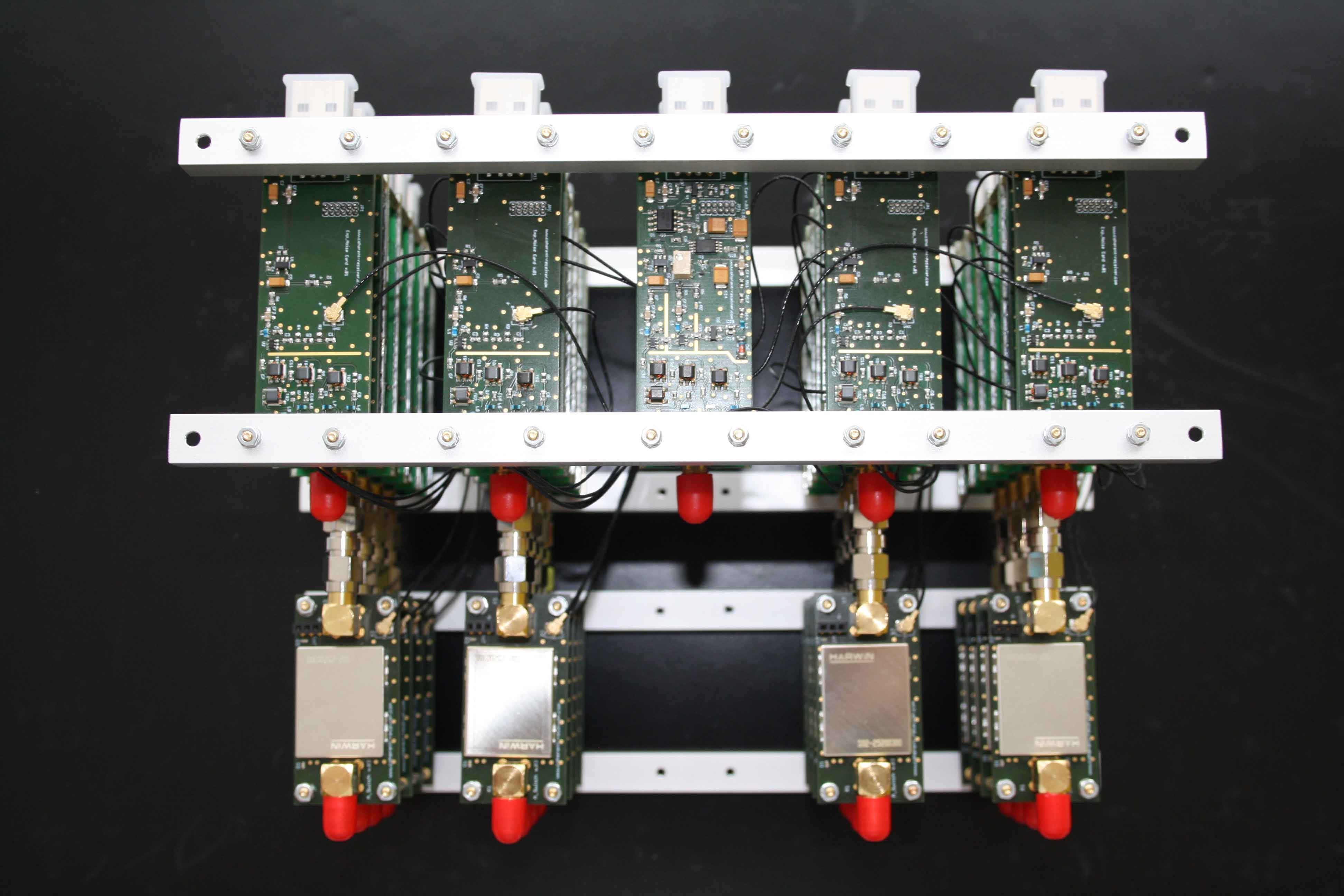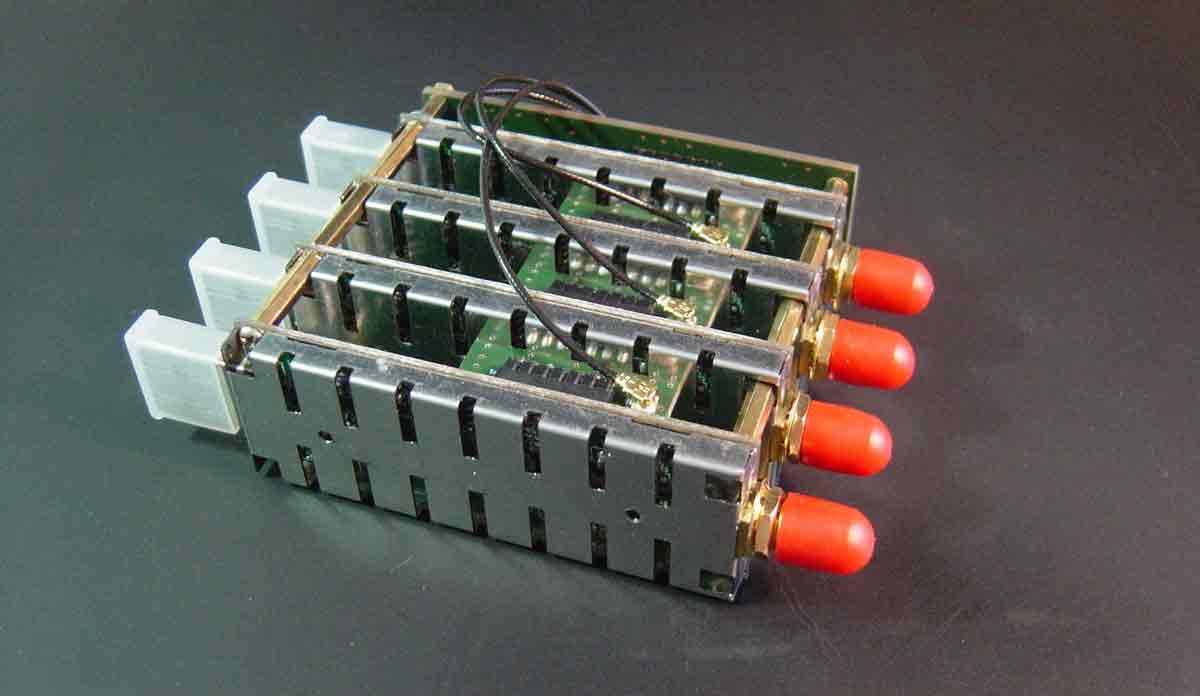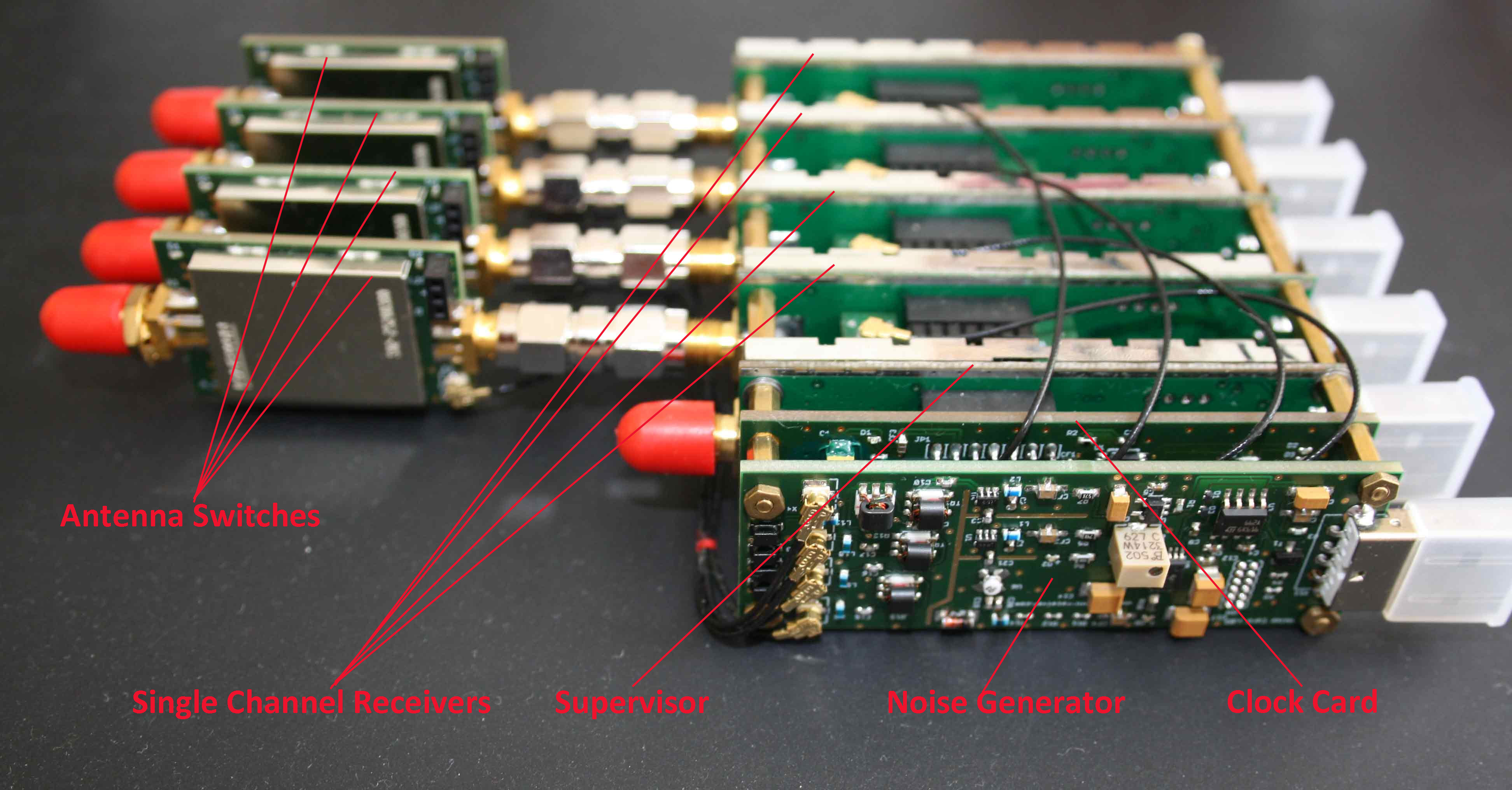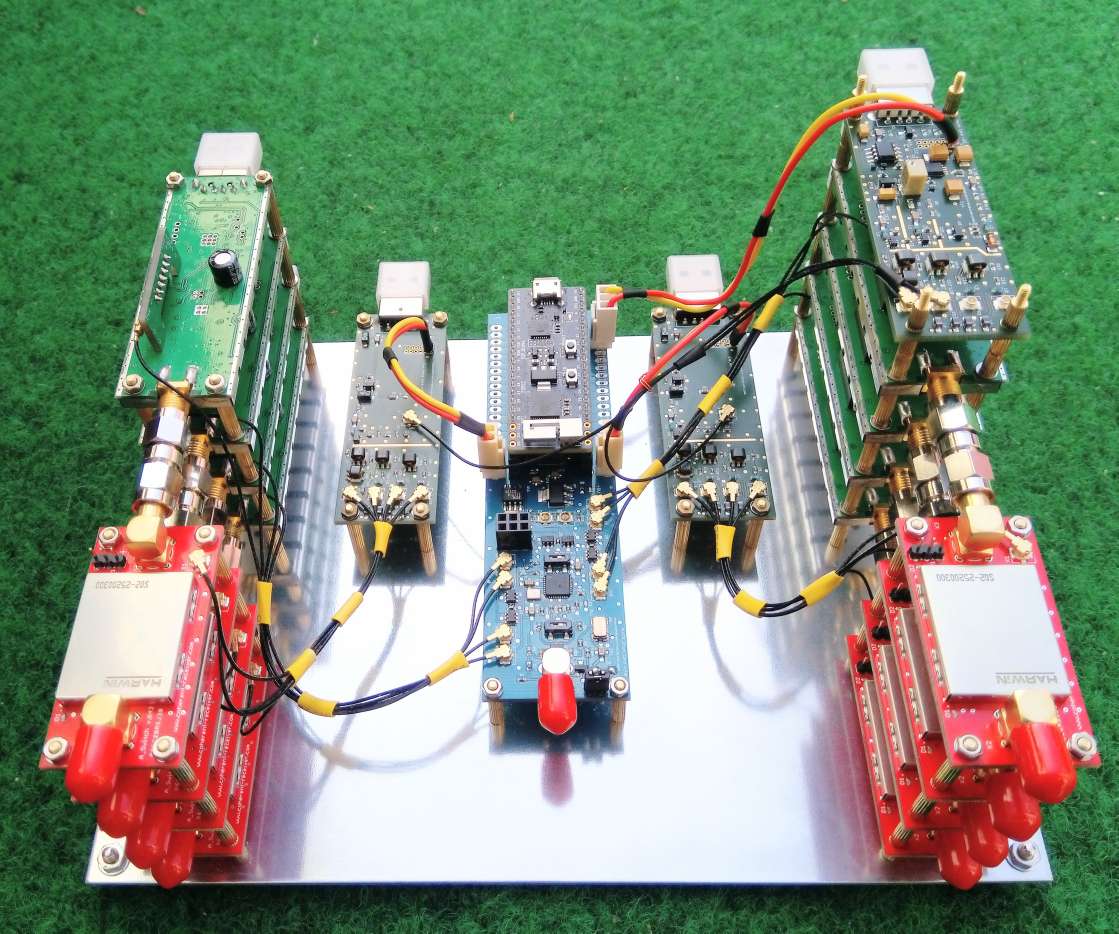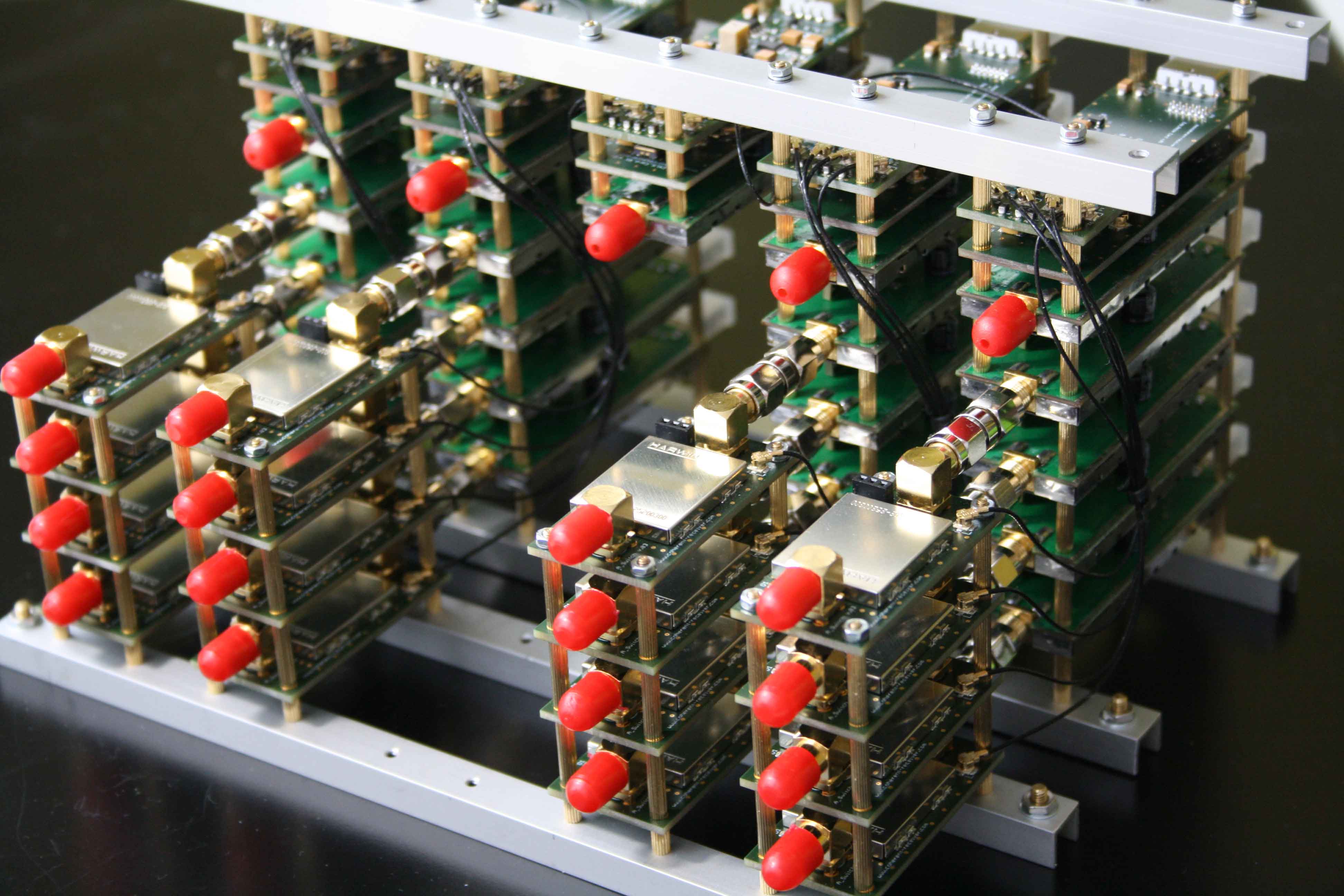RTL-SDR line is NRND (Not Recommended for New Designs). It is in production and available, with no obsolescence scheduled. However, we recommend against using these parts for new designs because there are better or more economical alternatives in terms of number of channels, resolution, bandwidth or power consumption. Please contact us for additional assistance in alternative designs in multi-tuner solutions.
Entry Level RTL-SDR
1 Clock Card (CLK_Card) is used for the realisation of the entry level receiver. Such architecture enables the configuration of up to 5 receiving channels. 4 channels are synchronised by the Buffer Clock 5PB1104 and 1 channel is synchronised directly by the TCXO 28.8 MHz (see the block-diagram for more details).
The 28.8 MHz output can be used for the connection of one or more single-channel receivers (using HF-adapter) or EXP_Card for the middle level configurations.
- ADC Resolution: 8 bit
- Clock: 28.8 MHz
- Temperature compensated oscillator (TCXO) : 2 PPM (2 PPM initial offset, 0.5-1 PPM temperature drift). Higher precision, e.g. 0.1, 0.5, 1.0 ppm, available on request.
- Female antenna port : SMA
- R820T2 tuner: 24 MHz – 1766 MHz (direct sampling with lower frequencies possible)
- Operation temperature: -10 to 60 ˚C
- USB powered bias tee: 4,5V
- Noise figure: 3.5 dB @ RF_IN
- Noise floor: –60 dBm
- Dimensions (RTL-SDR, CLK_CARD, EXP_CARD): 67 x 25 x 6 mm
Direction finding system (configuration: 4+1)
The Supervisor has following functions:
- power supply to the clock card
- I2C interface to the clock card and noise generator
- The Supervisor can be used as a normal receiver as well
The Supervisor can be tested by starting a SDR-programm, like rtl_fm or SDR#. Tune this receiver to the FM-Station and you have to get FM-signal without any additional steps or configurations. Single channel receivers have a common clock that is distributed from the clock card; you need to power on the supervisor in order to provide the power supply to the clock card. If the clock card is off, it cannot generate clock. Therefore, the system will not work.
Medium Level
1 Supervisory and 8 Coherent Channels
The Medium Level Receiver is based on the СLK_Card and EXP-Card (see block diagram). Sharing these cards allows the building of structures with up to 10 channels: 8 channels are identically synchronised by the buffer clock 5PB1104 (CLK_Card and EXP_Card), and 2 channels are synchronised directly by the TCXO 28.8. Note: the 10th channel is not shown on the diagram, but it is used as the power source for the EXP-Card. The 1st and 10th channel can be used in conjuction with channels 2…9 as coherent channels or remain independent (supervisory channels) for bandwidth monitoring or external management, e.g. I2C.
- ADC Resolution: 8 bit
- Clock: 28.8 MHz
- Temperature compensated oscillator (TCXO) : 2 PPM (2 PPM initial offset, 0.5-1 PPM temperature drift). Higher precision, e.g. 0.1, 0.5, 1.0 ppm, available on request.
- Female antenna port : SMA
- R820T2 tuner: 24 MHz – 1766 MHz (direct sampling with lower frequencies possible)
- Operation temperature: -10 to 60 ˚C
- USB powered bias tee: 4,5V
- Noise figure: 3.5 dB @ RF_IN
- Noise floor: –60 dBm
- Dimensions (RTL-SDR, CLK_CARD, EXP_CARD): 67 x 25 x 6 mm
Example of Medium Level Receiver with Antenne Switch Array and Noise Generator
4-8 channels receiver based on CLK_Card10 (ESP32-version)
This Medium Level Receiver is based on the СLK_Card (ESP32 edition) without clock expansion cards. CLK_Card (ESP32 edition) supports internal and external clock input with a software configurable clock frequency. Therefore, this receiver is not restricted to RTL-SDR and can be assembled with any other SDR supporting the external clock input.
Noise generator card, noise generator expansion cards and antenna switches are managed from ESP32 (we provide a simple demo with an internal http server showing the necessary functionality). This configuration can be used without noise expansion card; the required synchronisation signals can be provided from the existing transceiver, e.g. Pluto SDR.
This medium level receiver can be easily extended with 8 additional or more channels.
Advanced Level
1 Supervisory and 16 Coherent Channels
The Advanced Level Coherent Receiver is based on 1 CLK_CARD and 4 EXP_CARDs. Up to 4 single coherent receivers can be connected either to the CLK_CARD or to EXP_CARDs (see block diagram below for more details). The power supply of the EXP_CARDs can be taken from an external source + 3,3V, or from an additional single receiver. The configuration 1+16+4=21 channels is possible if the power supply results from the single receiver. You can add a further 5 channels by adding one more EXP_CARD and using the output 28.8 MHz. The resulting number of channels will be 21+5=26.
In general, you can reach an unlimited number of channels using the EXP_Cards and the tree structure.

The above presented schema enables the connection to each of the the 16 outputs 4 * 16 = 64 single coherent receivers resulting in a 64 channel coherent receiver. You can connect further 64 EXP_CARDS instead of single coherent receivers which results in the structure of 64*4=256 channels etc.
The time difference due to the delays in the different channel groups is constant and can be estimated during the receiver calibration using the external white noise generator (NG_CARD).
- ADC Resolution: 8 bit
- Clock: 28.8 MHz
- Temperature compensated oscillator (TCXO) : 2 PPM (2 PPM initial offset, 0.5-1 PPM temperature drift). Higher precision, e.g. 0.1, 0.5, 1.0 ppm, available on request.
- Female antenna port : SMA
- R820T2 tuner: 24 MHz – 1766 MHz (direct sampling with lower frequencies possible)
- Operation temperature: -10 to 60 ˚C
- USB powered bias tee: 4,5V
- Noise figure: 3.5 dB @ RF_IN
- Noise floor: –60 dBm
- Dimensions (RTL-SDR, CLK_CARD, EXP_CARD): 67 x 25 x 6 mm

